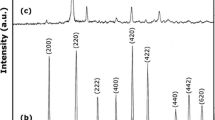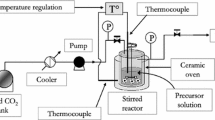Abstract
Titanium oxide (TiO2) nanocyrstals which are perfectly dispersed in organic solvents are synthesized by organic-ligand-assisted supercritical hydrothermal synthesis. The addition of hexaldehyde to the supercritical hydrothermal synthesis of TiO2 leads to the in-situ surface modification, which enables the synthsized TiO2 nanocrystals to be perfectly dispersed in iso-octane because of its hydrophobic nature. Further, the one-pot synthesis of hybrid materials results in the significant reduction of the particles size, probably due to the capping effect of hexaldehyde to suppress the particles growth.
Similar content being viewed by others
References
Adschiri T., Kanazawa K., Arai K. (1992). Rapid and continuous hydrothermal crystallization of metal-oxide particles in supercritical water. J. Am. Ceram. Soc. 75:1019–1022
Adschiri T., Hakuta Y., Sue K., Arai K. (2001). Hydrothermal synthesis of metal oxide nanoparticles at supercritical conditions. J. Nanopart. Res. 3:227–235
Bonnemann H., Braun G., Brijoux W., Brinkmann R., Tilling A.S., Seevogel K., Siepen K. (1996). Nanoscale colloidal metals and alloys stabilized by solvents and surfactants – Preparation and use as catalyst precursors. J. Organomet. Chem. 520:143–162
Horn D., Rieger J. (2001). Organic nanoparticles in the aqueous phase – theory, experiment, and use. Angew. Chem. Int. Ed. 40:4331–4361
Li L.M., Beniash E., Zubarev E.R., Xiang W., Rabatic B.M., Zhang G., Stupp S.I., (2003). Assembling a lasing hybrid material with supramolecular polymers and nanocrystals. Nat. Mater. 2:689–694
Mousavand T., Takami S., Umetsu M., Ohara S., Adschiri T. (2006a). Supercritical hydrothermal synthesis of organic–inorganic hybrid nanoparticles. J. Mater. Sci. 41:1445–1448
Mousavand T., S. Ohara, M. Umetsu, J. Zhang, S. Takami, T.␣Naka & T. Adschiri, 2006b. Hydrothermal synthesis and in␣situ surface modification of boehmite nanoparticles in supercritical water. J. Supercritical Fluids. (accepted)
Sanchez C., De G.J., Ribot F., Lalot T., Mayer C.R., Cabuil V. (2001). Designed hybrid organic–inorganic nanocomposites from functional nanobuilding blocks. Chem. Mater. 13:3061–3083
Singhal A., Skandan G., Wang A., Glumac N., Kear B.H., Hunt R.D. (1999). On nanoparticle aggregation during vapor phase synthesis. Nanostruct. Mater. 11:545–552
Acknowledgments
This work was supported by a Scientific Research Grant from the Ministry of Education, Science, Sports, and Culture of Japan (T.A.). This research was also partly supported by the HEIWA NAKAJIMA foundation (T.A.) and by a Grant-in-Aid for the COE project, Giant Molecules and Complex Systems, 2002.
Author information
Authors and Affiliations
Corresponding author
Rights and permissions
About this article
Cite this article
Mousavand, T., Zhang, J., Ohara, S. et al. Organic-ligand-assisted supercritical hydrothermal synthesis of titanium oxide nanocrystals leading to perfectly dispersed titanium oxide nanoparticle in organic phase. J Nanopart Res 9, 1067–1071 (2007). https://doi.org/10.1007/s11051-006-9186-2
Received:
Accepted:
Published:
Issue Date:
DOI: https://doi.org/10.1007/s11051-006-9186-2




